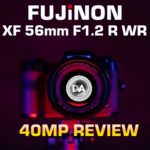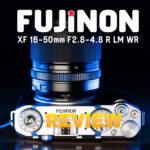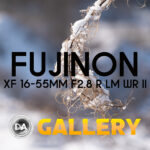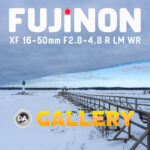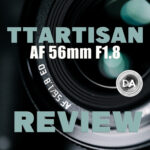
Fujinon GF 500mm F5.6 OIS Review
One of the indictments against Fuji’s medium format GF lineup has been in the limited number and variety of lenses. Until recently there were only 15 lenses available, and the longest focal length amongst them was the GF 250mm F4 OIS. But when you consider that focal lengths are registered in the full frame standard, and Fuji’s “crop” factor for medium format is thus 0.79x, that means that the full frame equivalence of 250mm on a GFX body is just 198mm, which isn’t exactly into serious telephoto range. That reach could be extended with the use of Fuji’s 1.4x teleconverter, but that still only gets you to about 277mm of effective reach. But Fuji announced a much longer telephoto alongside the GFX100S II body that I just reviewed in the form of the Fujinon GF 500mm F5.6 R LM OIS WR. With the crop factor, that’s equivalent to right under 400mm of reach, but add on that teleconverter and you’ve got 555mm of effective reach. This opens up whole new horizons for Fuji medium format shooters, and at $3499 USD, it is just $200 more than the 250mm F4. But is the longest of MF lenses worth buying? Find out by watching the video review below…or just reading on.
Follow Me @ YouTube | Patreon | Instagram | Facebook | DA Merchandise | Flickr | 500px | X
Thanks to Fujifilm Canada for sending me a review copy of this lens. As always, this is a completely independent review. All opinions and conclusions are my own. I’m doing this review on a 102MP Fujifilm GFX100S II.
__________________________________________________________________________________________________
If you don’t speak “Fuji”, here’s a quick breakdown of what all those letters mean.
- R = Aperture Ring
- LM = Linear Motors (focus system)
- OIS = Optical Image Stabilization
- WR = Weather resistance
The GF 500mm has pretty much all of the available Fuji features, so it gets all the letters. This is a very feature rich lens.

The GF 500mm is not a small lens, but the truth of the matter is that Fuji has actually done a really good job managing the size and weight of this lens. It was both smaller and lighter than what I expected, and while the build quality is not at the level of the super-teles (or even Fuji’s own XF 200mm F2 OIS), it strikes a nice balance between quality of construction and weight.
This is a very sharp lens. Combine the GF 500mm with one of Fuji’s 102MP cameras and sweet things happen. Take this shot, for example.

Unimpressed, right? But when I looked at this image at a pixel level, I noticed that there was actually a frying pan stranded out on that rock.

How did it get there? I don’t know, but it was clear as day when zooming into the image due to the crisp detail that the lens (and a good sensor) afford. But probably the bigger question is where or not the GF 500mm will actually open up new types of photography for Fuji’s MF system. That’s what we will explore in today’s review.
Build and Handling
While I noted that the size and weight is well moderated, that doesn’t mean that this is a small. It is still quite large, as you can see here.

It is 104.5 x 246.5 mm (4.1 x 9.7″), making it a good 43mm longer than the GF 250mm. We have a large 95mm front filter thread up front.
Add on that big hood (+95mm), and you’ve got a very long lens. The hood itself is made of plastic, but has a rubberized edge to allow you to set the lens down on the hood (often one of the safer ways to balance a big lens), a locking mechanism, and even a window to allow you to rotate a polarizing filter.

This is a weather sealed lens, and there is a gasket at the rear mount along with internal seals throughout.

You’ll note that there is a lot of depth in that mount, and that allows the 1.4x teleconverter to be mounted there.

That’s no small thing, as the Fujinon 1.4x has a serious protuberance at the front.

There will be relatively few lenses that have enough depth at their rear to accommodate this (only the 250mm and 500mm at present.) It’s also the most expensive teleconverter I’ve seen, carrying a whopping $850 price tag.
This is the most feature rich GF lens I’ve seen. There is a very nice setup for the tripod collar and foot, with the foot being very easily removable (a great design!).

Loosen that knob, then depress the release and the tripod foot slides right off. It can be executed in seconds. The lens becomes quite handholdable without it, too, as the weight is only 1375g (3lb) with the hood and foot removed.
Even better is the fact that the foot is Arca-compatible (hello, Canon, Sony, and Nikon!), which means that I can pop it right onto one of my tripods.

The collar itself is not removable, but it can be easily rotated by releasing the tension knob and turning the lens. Just tighten it back down when you get to the position you want.
There are also attachment points for a strap on either side of the lens barrel here.

Next comes a series of switches and controls. At the top is a two position focus limiter. It will allow you to eliminate the close focus possibilities under 5 meters (minimum focus distances is 2.8m) for snappier focus. Next comes a simple ON | OFF for the OIS system (it is a smart system that will determine whether or not you are panning).
Finally there is a three position switch that will allow you to choose AF-L, Preset, or standard AF modes. You can set the Preset focus position by using the button underneath the switch.

You can then hit one of the buttons towards the front of the lens located at the four pole positions, and focus will instantly revert to whatever the preset was. It’s a nice option when you are shooting in a situation where both your shooting position and your subject (or at least one of them) are at consistent positions.

Aperture is controlled via an aperture ring located between the switches and the broad manual focus ring. You can select aperture manually on the ring, and while the one third stop positions are not marked, there are light detents at each of them. You can also switch into either the Auto or Command positions by depressing the release button on the ring that will allow you to move either in or out of these options. The aperture iris itself has the typical nine blades.

The geometry of the specular highlights is reasonably circular (though with some deformation), but you can get slightly rounder specular highlights across the frame by stopping down.

The focus ring itself is nice and wide (as you can see above) and has a rubberized grip surface. It is very easy to distinguish between the focus and aperture rings even if you eye is pressed up to the viewfinder.

There’s no question that part of the light weight can be attributed to the use of plastics in the lens barrel rather than some kind of metal alloy. The latter is common in the better telephoto lenses, but there’s no question they were able to keep the weight down by using plastics instead. I suspect there will be a few who find the “feel” of the lens a little cheap for a $3500 lens, but the reality is that the lens will probably be nice and durable anyway.
The lens does feature an effective OIS system, and I found that it works very well despite the long focal length. The lens is rated at 6 stops of stabilization, and, of course, the camera I was using (GFX100S II) has a camera based stabilization system rated at 8 stops. That doesn’t add up to 14 stops, as the two systems will work in some degree of harmony, but I suspect with a practical limit not much higher than 8 stops. I was able to get a decent results at 1/4th second, which is 7 stops of assistance.

I was also able to get fairly steady results while shooting video, which is probably a more practical application than trying to shoot very low shutter speeds.
Minimum focus distance is 2.8 meters, or right over 9 feet. Not close, obviously, but that will get you a decent but not amazing 0.20x magnification.

Now if you happen to own the 1.4x TC, you can throw it on there, and because the minimum focus distance doesn’t change, and the focal length becomes 700mm, you get a much higher level of magnification.

So yes, while some might find the build feel a little plasticky for a $3500 lens, I’ve come to appreciate the balance of what Fuji has done here. This is a feature rich lens that manages to stay reasonable in both size and price, so that’s a win.
Autofocus and Video
It is rare that I’m fully impressed with a Fuji product when it comes to autofocus, but this is obviously a very critical lens for Fuji. They are trying to expand the horizons of what medium format can do. So autofocus needs to work here. They have employed what appears to be a single linear motor in the design (I looked pretty carefully at their marketing language). This strikes me as being a bit underpowered when it isn’t unusual for similar lenses on full frame to have dual and even quad linear motors. Still, the linear focus motor is Fuji’s premium autofocus motor, and the focus sound is nice and quiet. I can hear a very faint whirring if I put my ear right up next to the lens barrel, but that’s about it.

Focus speed, however, isn’t nearly as fast as what I’ve come to expect from recent lenses. I reviewed the Sigma 500mm F5.6 DN Sport on Sony a few months back, and there’s no question that focus was much, much faster with the Sigma lens. You can feel inertia building a bit during focus, and it unfortunately isn’t unusual for focus to do a rack in the wrong direction before correcting to the right direction. All of this adds some additional time to focus acquisition. I feel like the current iteration of Fuji’s focus system in their cameras is squeezing probably the last bit of performance out of what is (underneath the AI processing) some aging hardware.
So acquiring birds in flight (a natural subject for this lens) was sometimes frustrating, as the focus motor was not reactive enough to grab onto the moving target. I got far more images like this that what I would like!

It takes a bit to acquire focus sometimes, and once the AI is tracking, it does reasonably well, but the perfect focus rate is still considerably below what I expect from the cameras I personally own. I had some definite misses in sequences where I would typically expect to get well focused results.



But other situations the tracking did fairly good until the subject got too near the edge of the frame. There is some blackout in between frames on Fuji’s cameras, which makes it a little harder to smoothly pan with the subject.






Focus reactiveness is still not on par with any of the current full frame options, so there will be plenty of moments where focus is still adjusting and you miss the shot. And sometimes focus will sometimes get “stuck” and it takes focusing on a difference subject or even manually focusing to get things where you want. But fortunately most of the time focus works pretty well. And when you nail focus, you can get amazing detail (even with the 1.4x TC attached, so 700mm here).


For more moderate subjects, focus is fast enough and the lens delivers simply lovely results.

The AI Tracking did a good job with other subjects as well, with a little green box appearing tracking ants on my hive when I shot in the appropriate mode. Sometimes focus wasn’t quite on the head (torso instead), but, to be fair, that is a tiny target.


I did a bit of taking photos of a speaker at our church, though the focal length is pretty long for that kind of work and the aperture a little slow for that kind of light. But focus did just fine, even shooting at ISO 3200 and 6400 to account for the lighting.

With normal (non fast moving subjects), focus was great. It delivered good accuracy and great results.

But when you introduce the variable of movement, results are largely going to be dependent on getting a good early lock on your subject and keeping them well framed if you are tracking action. And focus just wont be reactive enough to track a subject moving quickly towards the camera. Plan on plenty of missed shots in that scenario.
And video focus needs to be pretty much just on either still or extremely slow moving subjects. I tried to shoot some video of Nala moving towards me, and focus just didn’t seem to move. Even when I started shooting a still shot of her, so AI was tracking her eye already, and she decided to trot over towards me, focus just lost it altogether.
I was essentially unable to get focus to move when touching the screen to select a new focus point, so I find it hard to recommend this lens for video unless you want to shoot mostly static shots to compliment your stills.

You can capture some action with the GF 500mm, but it will require some good technique and some patience, because you will have some missed shots. Autofocus is pretty good by Fuji and by medium format standards, but not really when compared to smaller formats.
Image Quality Breakdown
Ahhh, it is a relief to land here, as I have no real reservations in this section. The GF 500mm employs 21 elements in 14 groups, and this includes 2 Super ED elements 5 ED elements.

The MTF chart looks fantastic, with very high sharpness even at the high lp/mm standards. The lowest that we ever see even on the edge of the frame is about 79%, and the center is essentially perfect.

There is essentially no reason to shoot at anything other than F5.6 unless you want more depth of field, as sharpness is pretty much perfect even wide open.


We’ll break down the details together. *A few caveats about my chart tests, which I’ll rely less on here and more on real world results. I set up to shoot these tests outdoors due to space constraints indoors. That introduces some extra variables due to the movement of wind on the chart or the tripod, so I’m parsing the data with that in mind.
First of all, let’s look at vignette and distortion. There’s not much to see on either front.

I used a -2 to correct the tiniest amount of distortion and a +32 (just a little over a stop) to correct the vignette. That’s pretty much meaningless, so you’ll never have to worry about that.
I saw zero issues with fringing. You can see from this high contrast white blossoms shot that even in a crop you can see no fringing as you transition from docus to defocus.


Lateral chromatic aberrations show up near the edge of the frame in transitions from dark to light areas. You can see from the edge of my test chart Fuji has also nailed this metric, and there is next to no fringing in the transitions from black to white.

So clearly no optical issues in this basic areas.
So how about resolution? The 102MP resolution point is the highest that I’ve personally tested on, but the GF 500mm has no problem keeping up with this very high resolution. Here’s a look at the test chart that crops throughout the review come from:

And here is a look at F5.6 crops from the center, then mid-frame, and then extreme lower right corner:



That’s great sharpness, and it holds up in real world shots. Here’s a deep crop from another image.

Long landscape images are a little tougher with telephotos, as there tend to be pockets of warm or cool air that cause shimmering and/or distortions. Under the right conditions you could expect to get great results, but almost never when shooting over water.

I found very good centering on the copy of the lens I tested, with even results in all four corners.
Stopping down makes only a minimal difference in sharpness, so only stop down when you need more depth of field. They have clearly optimized the performance for wide open.
Adding the 1.4x TC doesn’t seem to make a huge impact on sharpness. Here’s an example at 700mm, F8:


Minimum aperture is F32. You’ll see the effects of diffraction after F11, with the image looking considerably softer at F32:

Bokeh quality is very nice. I found that even shots at distance had a nicely blurred background.

At closer distances the subject isolation is obviously intense.

Specular highlights aren’t perfectly round, as mentioned, but this image still looks pretty nice!

If you are close to your subject, there essentially won’t be any background!

A very long focal length means that you won’t often have to deal with flare issues, but I did shoot into the sun a few times without any kind of issue.


I typically find Fuji glass to have great color, and that’s certainly no exception, particularly when you pair it with the gorgeous sensor in the GFX100S II that I was using for this review.

In short, there is basically nothing that I have to complain about here optically. This is a wonderful example of how to do lens design, with optics that deliver both high contrast and resolution while also giving lovely bokeh. Kudos to Fuji! You can check out the image gallery if you’d like to see more.
Conclusion
The Fujinon GF 500mm F5.6 R LM OIS WR is a very important lens for Fuji. It is twice as long a focal length as the previous longest lens for the platform, and is much more of a legitimate telephoto than the GF 250mm F4. Fuji has found a nice balance of features and performance while keeping the size, weight, and price reasonable.

I’m somewhat underwhelmed by the autofocus performance here (particularly for video), but that is often par for the course with Fuji. I’ve never gone birding with a GFX body before, so this is obviously pushing the limits of what you traditionally do with medium format. I do think that Fuji will continue to improve in this area, but I think it is going to take a serious hardware upgrade. Hopefully when that day comes the GF 500mm will be an even more effective lens.

The image quality is pretty fantastic here. I don’t really have any complaints in that regard, as the lens really does deliver beautiful results. I’ve certainly shot with telephoto lenses that were a little easier to acquire subjects with, but I’ve rarely shot anything at any price point that delivered better results. If you are a person already invested in Fuji’s GFX system and have been waiting for a longer lens, that wait is over. And if you are a person that has been on the fence about whether or not to take the plunge into MF, the GF 500mm may just be the lens to convince you that Fuji is serious about this platform. I’ll say this in conclusion; my review period was just not long enough. I’d love to have many more opportunities to make beautiful images with this lens.

Pros:
- Nicely built lens
- Size and weight is kept moderate
- Full weather sealing and fluorine coating
- More feature rich than any GF lens I’ve used before
- Compatible with 1.4x teleconverter for more flexibility
- Love the tripod foot design
- Focus motor is nice and quiet
- Focus accuracy with still or slow moving subjects is good
- Basically no distortion or vignette
- Low chromatic aberrations
- Awesome sharpness across the frame even at F5.6
- Lovely bokeh
- Good flare resistance
- Great colors and contrast
Cons:
- Focus experience can be exasperating
- Video AF is poor
- Some may find the build a little plasticky for the price
_________________________________________________________________________
GEAR USED:
Purchase the Fujinon GF 500mm F5.6 @ B&H Photo | Adorama | Amazon | Camera Canada | Amazon Canada | Amazon UK | Amazon Germany
Purchase the Fujifilm GFX100S II @ B&H Photo | Adorama | Amazon | Camera Canada | Amazon Canada | Amazon UK
_____________________________________________________________
Purchase the Fujifilm X-H2 @ B&H Photo | Adorama | Amazon | Camera Canada | Amazon Canada | Amazon UK | Amazon Germany
_______________________________________________________________
Purchase the Fujifilm X-T5 @ B&H Photo | Amazon | Camera Canada | Amazon Canada | Amazon UK | Find it Used at KEH
________________________________________________________________
Purchase the Fujifilm X-S20 @ B&H Photo | Adorama | Amazon | Camera Canada | Amazon Canada | Amazon UK | Amazon Germany |
_________________________________________________________________
Want to support this channel? Use these affiliate links to shop at: B&H Photo | Amazon | Adorama | Camera Canada | Amazon Canada | Amazon UK | Ebay | Make a donation via Paypal
Buy DA Merchandise https://bit.ly/TWIMerch

Keywords: Fuji, Fujinon, 500mm, Fuji 500mm, GF 500mm, GF, AF, Autofocus, 500mm, F5.6, f/5.6, R, WR, Weathersealing, LM, OIS, Fuji 500mm Review, Fuji GF, Fujifilm, G-mount, Medium Format, Review, Telephoto, Action, Tracking, Hands On, Dustin Abbott, Real World, Comparison, Sharpness, Bokeh, Flare Resistance, Autofocus, Image Quality, Sample Images, Video, Photography, Fujifilm GFX100S II, GFX100 II, let the light in, #letthelightin, DA


